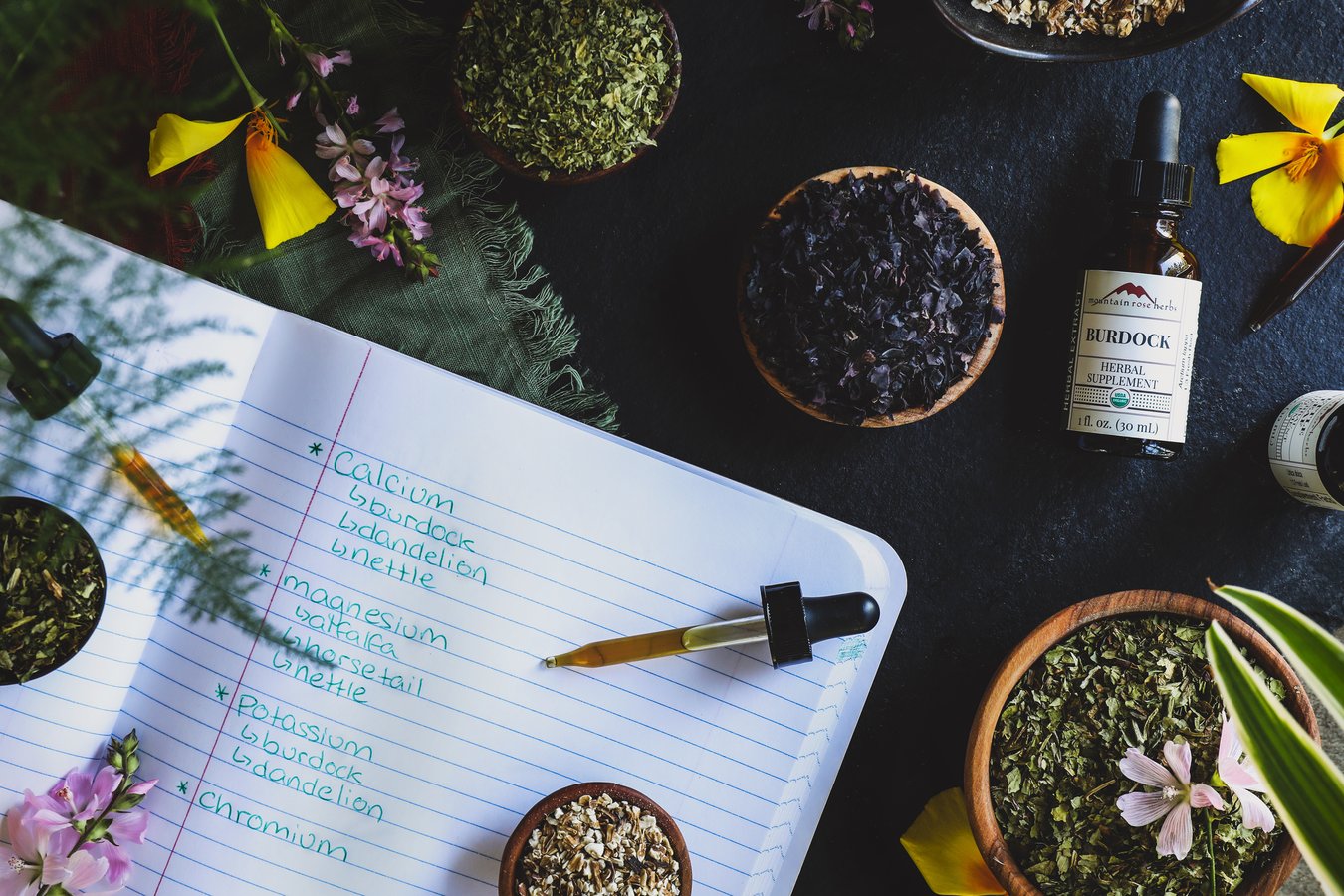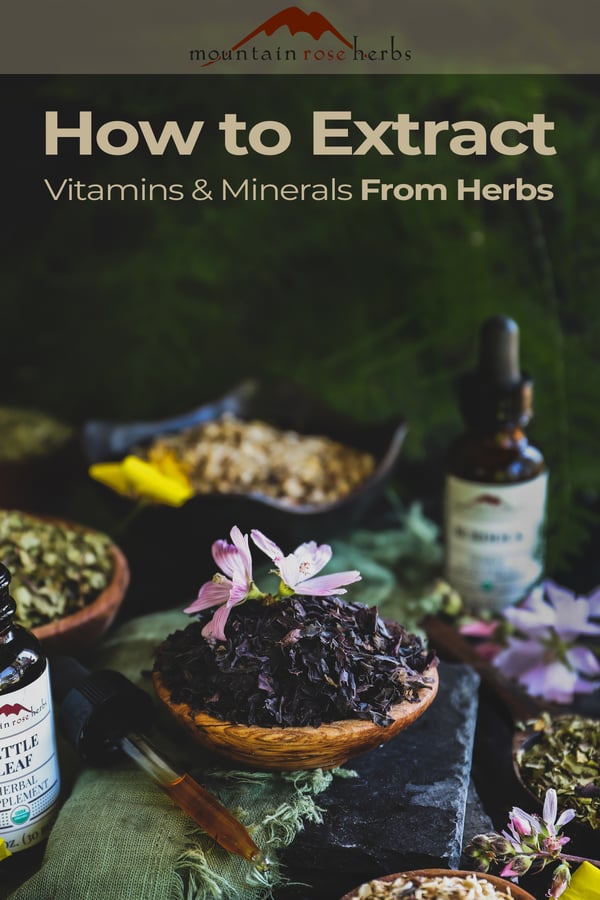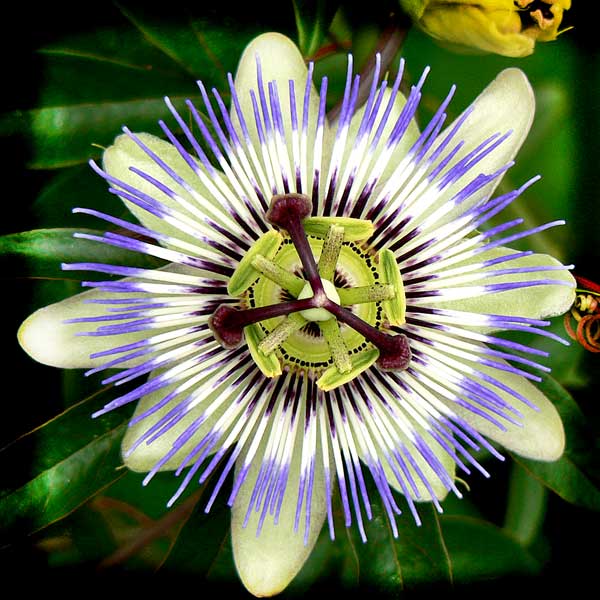Continuing our study of phytochemistry, the focus of this post is on the nutritional benefits of plants. Every plant needs vitamins and minerals to thrive just as we do. In turn, plants are fantastically nutrient-rich, some more than others. We’ve been told to eat our veggies because they’re good for us! All cultures cook with botanicals for taste and health. However, there are also other excellent ways to incorporate the nutritional benefits of plants. We can readily extract plant nutrients in low ethanol (<40%) alcohol tinctures, in water, and in herb-infused vinegar and honey. Let’s delve into how to extract vitamins and minerals in plants, preserve them, and utilize them in ways our loved ones will enjoy taking.
Common Nutrients in Plants & What They Bring to the Nutritional Table
- Calcium is responsible for muscle contraction and relaxation, anxiety relief, nerve impulse transmission, bone building, and proper functioning of the heart and kidneys. Calcium plays a part in the chain of events that coagulates blood after an injury. Incidentally, Vitamin D is required for optimal calcium absorption and the sun is the best source.
- Magnesium strengthens cell membranes, aids in the relaxation of cramping muscles, and supports a healthy immune system. It helps to lift and calm the mind and emotions.
- Potassium regulates fluid balance and nerve signals and stops muscle spasms. Potassium also protects the heart. It’s best to get potassium from food sources vs. supplements as too much potassium intake can cause health issues.
I call calcium, magnesium, and potassium the nutrient trifecta as they work so well together to keep us calm and to aid in recovery from muscle cramping and restless leg syndrome.
- Chromium helps to clear acne, slows the aging process, and stimulates insulin production.
- Copper aids in easing arthritis pain and fatigue, and inhibits inflammatory markers. It breaks the structural membrane of viruses and bacteria.
- Iron is the mineral that attaches itself to a blood cell and attracts an oxygen molecule from the lungs. The blood cell then travels to the capillary beds where the oxygen molecule jumps off, enters mitochondria in the nucleus of a cell, and causes a reaction that violently breaks apart molecular chains to create energy, aka ATP. That’s called the Krebs Cycle, my friends.
- Niacin helps relieve vertigo and hangovers, protects the cardiac system, and aids in easy breathing.
- Phosphorus stimulates the immune system and plays an important role in the formation and strength of bones and teeth. The body needs phosphorus to make proteins for growth, maintenance, and the repair of cells and tissue. It is an essential component of cell membranes and is required by every cell in the body for normal function.
- Selenium is a trace mineral, meaning small amounts are all that is needed. Selenium helps to slow aging; make healthy hair, nails, and teeth; and contributes to less cardiovascular disease. Selenium gives our cells structure, prevents cellular damage, increases antioxidant capabilities, helps the body to resist disease, boosts immunity, regulates thyroid function, and defends against heart disease.
- Thiamin aids in the reduction of heartburn, protects the nerves, helps to prevent canker sores, and can help to relieve migraines and fatigue.
- Zinc stimulates the immune response and the production of insulin, helps allay dandruff, and plays a role in healthy gums. Zinc is required for the ability to smell and taste. It aids in wound healing, cell division and growth, and the breakdown of carbohydrates.
How Vitamins and Minerals Are Extracted From Herbs
While we can add nutritious herbs to soups, salads, sandwiches, and a myriad of culinary delights, we do have some menstruum available to us that will extract the vitamins and minerals from plants.
- Vinegar extracts vitamins, minerals, flavonoids, flavors, and some essential oils and alkaloids from plants. The acidic nature of vinegar also assists in the uptake of calcium and iron into our cells.
Vinegar extracts are a fabulous way to get the nutrients from plants into the foods we eat. You can simply add a teaspoon to a tablespoon in drinking water, on salads or cooked greens, blended with marinades, bbq sauces, sandwich spreads, and of course, pickles.
- Honey can easily extract and preserve some alcohol soluble constituents and is hygroscopic, meaning water attracting. As vitamins and minerals are, generally speaking, water soluble, honey is an excellent vehicle for pulling out and preserving the nutrition from plants.
Raw honey also contains many nutrients from the flowers the bees sipped from and made into honey. Herbal honeys are just the ticket to getting plant nutrients to our loved ones. They can be drizzled on granola and yogurt, used in no-bake brownies and herbal truffles, on cornbread, and in teas and lemonades. The possibilities are as endless as our culinary creativity.
- Water is known as the universal solvent, although some constituents, such as fats/lipids, and resins are opposed to it. Water will extract vitamins and minerals from dried plants into teas, decoctions, syrups, and soups. Muddling peppermint, lavender, or even rosemary and allowing them to soak in water in the sun will extract some nutrition and most definitely essential oils.
- Alcohol is not generally thought of as a menstruum for extracting minerals. However, as most are water soluble, 80-100 proof alcohol can be used for tincturing. Have you ever made a fresh nettle tincture and noticed a dark greenish film on the inside of the jar? That’s iron that has precipitated out!
Four Best Herbs With Vital Nutrients
Burdock roots (Arctium lappa) can be used in soups and stews, stir-fries, tinctures and oxymels. It contains inulin, which is a complex carbohydrate. When you make liquid extracts from burdock root, you’ll notice a white chalky substance on the bottom of your bottles. That’s the inulin, a fructan made up of chains of fructose molecules that are not digested in the small intestine. Also known as fiber, inulin travels to the lower gut, where it functions as a prebiotic—a food source for beneficial gut bacteria, making for a more healthy functioning digestive system. Inulin aids in the removal of waste and allows for more complete elimination. Yay team inulin! Furthermore, burdock contains calcium, anxiolytic glycine, iron, magnesium, phosphorus, and potassium, and is packed with healthy polyphenols.
Dandelions (Taraxacum officinale) are a superfood, in my opinion. When I look at the list of nutrients that dandelions embody, I wonder what this “weed” can’t do! Antioxidants; the trifecta of calcium, magnesium, and potassium; iron; phosphorus; selenium; and zinc are just a few of the nutrients in dandelions. Like burdock roots, the roots of dandelions contain healthful inulin. Roasted dandelion roots are a boon to those who wish to enjoy a dark, rich beverage without the caffeine jitters. Dandelion greens pesto is a favorite of my students and one we can make all spring and summer long.
Nori (Porphyra umbilicalis) is known for its carotenes, vitamin C, and vitamin B12, which is seldom found in land plants. At 28% protein, nori has more protein than sunflower seeds and wheat germ, both of which are promoted as good sources of protein for those who eat no animal products. Its nutty, sweet-salty flavor makes it a popular addition to soups and salads. It’s also fabulous on popcorn, scrambled eggs, and avocado toast!
As space is running short, let’s end with of my favorite wild plant, Nettles (Urtica dioica). Nettles are always the talk of the town for being super nutritious, being loaded with calcium, iron, magnesium, and zinc, and a plethora of antioxidants, including chlorogenic acid, pantothenic acid (Vitamin B5), and quercitin. Dried nettles are wonderful in tea and spaghetti sauce, and powdered in herbal truffles. Fresh spring nettle tincture and infused vinegar is just the tip of the iceberg of what we can create with nettles.
Really, plants contain many more nutrients than I can list in this short post. For more info on the mineral and vitamin content of individual plants, refer to Dr. James Duke's Phytochemical & Ethnobotanical Databases. Until next time, I leave you wild about plants!
Want to Learn More from Suzanne Tabert?
Explore the Cedar Mountain Herb School
You may also be interested in
*The statements in this blog have not been evaluated by the Food and Drug Administration. These products are not intended to diagnose, treat, cure, or prevent any disease. We recommend that you consult with a qualified healthcare practitioner before using herbal products, particularly if you are pregnant, nursing, or on any medications. For educational purposes only.














